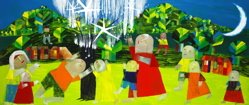It was a close call between her story, Christopher Rosales' "May Naninirahang Gubat sa Aking Balat" and Raymond Falgui's "The Gray Lady, the Gray Girl and the Miracle of Colors."
The other finalists were "The Flower Girl" by Evita Guinto, "The Day the Colors Came" by Migs Marfori, and "Ang Regalo ni Nanay" by Alice Mallari.
The judges this year were writer Gary C. Devilles who teaches Philippine Literature, Art Appreciation, Political Economy of Mass Media in Ateneo de Manila University, De La Salle University, University of Sto. Tomas, and Far Eastern University; Dr. Dina Ocampo, current dean of the University of the Philippines College of Education and co-founder of Wordlab School Inc., a non-stock, non-profit institution that provides school program for children with dyslexia and other learning disabilities; and Gigo Alampay, executive director of CANVAS.
Congratulations to Frankie Torres and to all the other finalists! CANVAS wishes to also thank all the other writers who submitted entries. We look forward to everyone's continued participation and support in our future competitions.

BLUE STARS
by Francesca Nicole Torres
by Francesca Nicole Torres
This is a story about a lie that becomes a truth, if only one believes in it, and keeps believing, even when everything else says to do otherwise. It is a story about one of the most powerful things on earth.
In a time of war, there was a small village. It was hidden, cradled like a fragile baby bird, in a valley surrounded by steep mountains. Living in the village was like living in another world: a world of laughter, of song, and of joy. Men joked as they worked. Women sang as they did chores. And as for the children, the streets were filled with the sounds of their play, from morning till night.
But above all, what made this village very special were the flowers. The blooms grew wild in the fertile soil of the valley, explosions of color reaching towards the perfect patch of sun.
There were loud, red poppies; hardy, pink dog-roses; dainty, white lilies; and cheerful, yellow sunflowers.
But most of all, there was an endless carpet of small, blue stars, glistening in the grass like a constellation that had fallen out of the sky. They looked delicate and fragile, not wild and strong like the others. Many marveled at how healthy and how vibrant they were, with no one to care for them.
Well, that wasn't completely true. These flowers had one caretaker. She was a little girl. Her name was Nadia.
Ever since she was old enough to walk, Nadia had taken care of the little blue flowers. In the mornings, before the sun was up, she watered them. In the afternoons, she whispered to them. And at night, before she went to bed, she made sure to wish them sweet dreams. As long as she had her flowers, she was happy, and as long as she took care of them, they bloomed in abundance, for nothing makes a flower bloom more than love.
So Nadia’s joy became the joy of the village. And for a long time, everything was as it should be.
But this was a time of war, and though the steep mountains that surrounded the valley shielded the village for a time, they could not shield them forever. One moonless night, while Nadia was out in the flower fields, she heard it: a low rumbling, like the sound of distant drums. When she turned towards the direction of noise she saw, in the distance, the red glow of fire. Then there were more rumbles, getting louder and louder.
Nadia ran. She told her parents, who passed the news on to the rest of the village. From that moment, things started to change.
The frightened girl did not understand what those noises meant, but rest of the village did: the war was coming for them. They had hoped that the cradle of mountains would keep them safe until it was over, but that was before they had know there were bombs. Bombs could make mountains disappear in minutes.
There was no more laughter in the village now, no more time for singing or dancing or playing in the streets. Instead, there was panic. Villagers rushed to and fro, making preparations for their escape. Every day, they gathered supplies and made plans. Every night, they watched as the glow from the fires grew closer and closer, and prayed the bombs would pass them over.
There was no joy anymore...except for the flowers.
So strong was Nadia’s love for her flowers that no matter how scared she was, she could not forget them. So, in the mornings, before the sun was up, she still got up to water them. In the afternoons, she still whispered to them. And in the evenings, as the bombs went off and fire burned in the distance, she still wished them sweet dreams.
So her delicate flowers continued to bloom, full of life and joy, and for a moment, looking at them, the villagers could forget that there were bombs and gunshots and fires. They could forget that there was a war.
Then, one night, while Nadia was fast asleep, the war finally came.
There was no time to lose. As the flames began and the explosions shook the ground, the villagers ran for shelter in the mountains. Nadia spent the long night huddled in the dark, with her family, listening to roaring of the bombs and the crackling of the fire as it burnt through the village.
Finally, just before the sun came up, the bombs stopped and all was quiet. Slowly, the villagers made their way back to what remained of their home. They walked through the ruins in silence. Finally, they reached the fields.
The poppies were ashes, the dog-roses cinders, the lilies and sunflowers burnt to a crisp. But worst of all…
“My flowers…they’re gone!” Nadia cried. She ran through the burnt grass, looking for one petal, one shrub, one sign of life, one star…but there were none. No trace remained of the small blue flowers she had showered with love and care. Nadia fell on the ground and began to cry.
At the sight of this little girl, crying for what she had lost, the other villagers too started to weep. They mourned for the flowers. They mourned the village. But most of all, they mourned for the joy they felt would never come back.
For four days, there was only the sound of weeping in the village. But then, on the fifth day, just like before, Nadia got up before the sun rose, walked to field, and started to water the burnt earth, just as she had always done. In the afternoon, she whispered to what remained of the grass. And in the evening, she wished the field sweet dreams.
She did this again on the sixth day, and on the seventh day, and on the eighth day, and on the ninth day…
And on the tenth day, when she visited the field, she saw a faint glimmer of blue: a small blue star lay blooming in a patch of grass. She let out a cry of joy so loud that the whole village came running to the field to see what the noise was about. And when they saw it, the people cheered, and Nadia smiled.
They began to rebuild soon after. Men joked as they worked. Women sang as they helped build. And as for the children, the streets were filled with the sounds of their laughter again, from morning ‘till night.
And as for Nadia, and her flowers, well…
In a month, the grass was green again.
In two months, buds started to push up from the earth.
After a year had passed, from that one small blue flower, the field had grown again, and with it, joy finally returned to the village.
Many years have passed since then, and many things have passed with it. Nadia, once a little girl, has since grown up, and grown old, and gone. The village, too, is different: mountains have given way to roads, and what once was a small and hidden world is now a bustling town.
But the blue stars still remain, blooming like a constellation fallen from the sky. And, every day, a group of children water them in the morning, whisper to them in the afternoon, and wish them sweet dreams at night.
This is a story about a lie that becomes a truth, if only one believes in it, and keeps believing, even when all is burnt away and there seems to be nothing left. It is a story of love and loss and sadness and joy. It is a story about one of the most powerful things on earth.
It is a story of a little girl and her flowers.
It is a story of hope.
* The painting is the untitled contest piece by Liv Vinluan, which served as the inspiration for this year's children's story writing competition.









